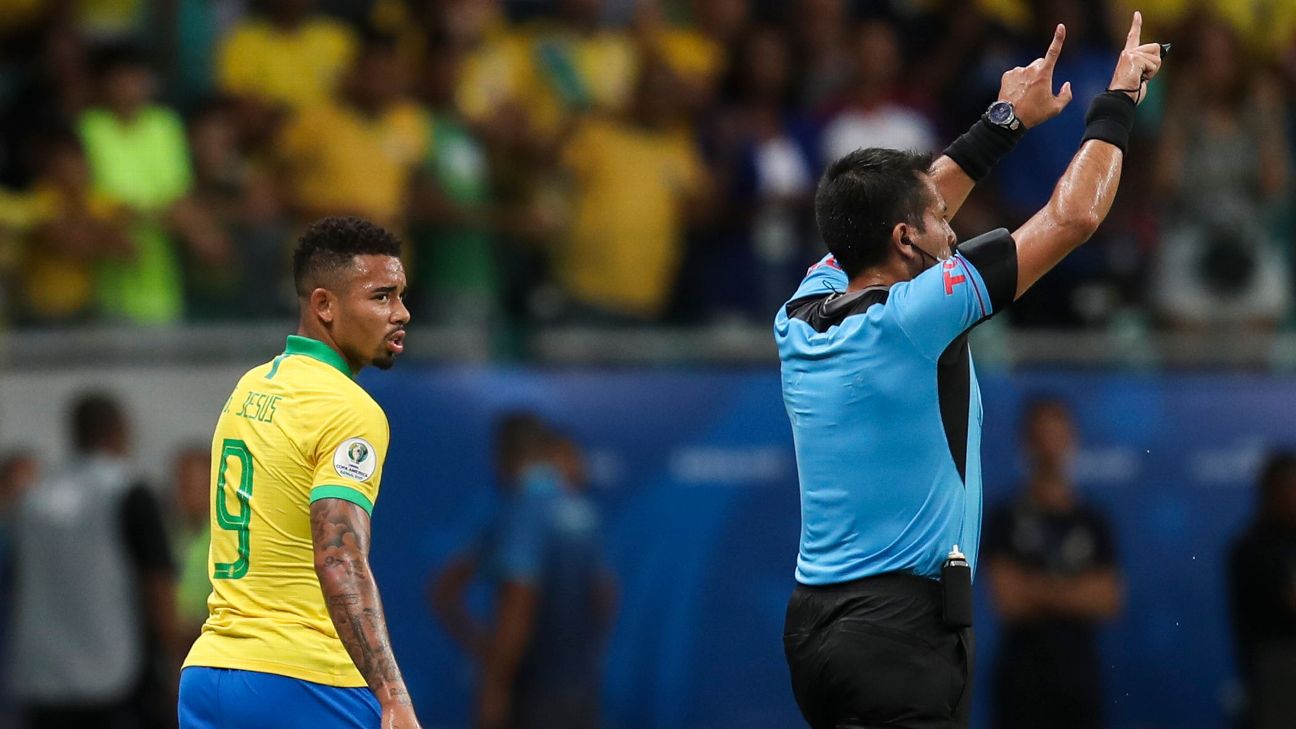
What VAR gives, VAR can take away. In Friday’s Copa America opening win against Bolivia, Brazil’s breakthrough came when a new handball ruling gave them a penalty, which Philippe Coutinho converted. Four days later against Venezuela they had the ball in the back of the net three times, but none of them counted. One was ruled out for a foul, the other two for offside after lengthy consultation with the video evidence.
Three disallowed goals might make it seem as if Brazil were always knocking on the door. But for all the possession they enjoyed in Salvador, Venezuela keeper Wuilker Farinez had just one serious save to make, and only a handful of moments to cause him alarm.
– Copa America: All you need to know
– Full Copa America fixtures schedule
– Watch every Copa America match on ESPN+
Brazil left the field to resounding boos. The goalless draw, though, is not a disaster. In the history of the Copa with 12 teams, no side with four points has ever failed to make the quarterfinals. Saturday’s game against Peru will not be a matter of life and death — although the players will probably not relish returning to Sao Paulo, where the supporters are notoriously intolerant.
But if the hosts’ place in the last eight would seem assured, all is not well — and has not been well ever since the defeat to Belgium in the quarterfinals of last year’s World Cup.
This was the second — and so far last — defeat suffered by Brazil in the nearly three years that Tite has been in charge. The only other loss came in a friendly against Argentina when an experimental side was fielded. That Belgium game, then, is the only defeat of note. But it continues to ripple through the mind of the coach. The subsequent results have been acceptable — 10 wins and two draws — but the level of performance has consistently been disappointing, especially in the final third of the field.
Tite recognises the problem. He knows that the attack is not clicking as it did so naturally at the start of his reign. Back in 2016 he took a gamble on a teenage centre-forward named Gabriel Jesus, who immediately appeared to have solved what had bizarrely become a problem position for the national team. All went well until the World Cup, when Jesus hit a run of poor form. Tite bitterly regrets not dropping him earlier — and did leave him out of his first post-World Cup squad.
Roberto Firmino became the first choice centre-forward. But his undoubted virtues have yet to be hard-wired into the side. The context is very different from that of Liverpool, where he works as frequently the deepest lying of the front three. The training sessions in the build up to the Copa should have been vital for fitting him into to the team. But Firmino was busy with the final of the Champions League, and turned up late. With Jesus in form — five goals in Brazil’s three games going into the Copa — it was something of a surprise when Tite stuck with Firmino. And the way that he shuffled his pack in the second half against Venezuela revealed a mind in confusion.
Firmino, of course, is not a traditional centre-forward. The penalty area presence is supplied by Richarlison, cutting in from the right. But he was surprisingly removed at the interval. Jesus came on, but to operate on the flank rather than in the middle. Jesus started on the right — the position where Everton came on to score a stunning solo goal last Friday. If the crowd was displeased not to see Everton, they were further vexed by the appearance of Fernandinho, who replaced Casemiro — a switch greeted with incomprehension by the local media. And Everton finally emerged for the last 20 minutes in place of winger David Neres. Firmino stayed, in what will be seen as an act of stubbornness from the coach.
There are positives. Everton is probably the main one. His goal last Friday came when he cut inside onto his stronger right foot. Mindful of this, Venezuela left him the corridor outside and he used it to put in a left-footed cross that, but for the intervention of VAR, would have set up the winning goal from Coutinho. He has made himself an important option for the rest of the tournament.
And the return form injury of Arthur made the midfield slicker. There were times when the ball was moved more crisply than against Bolivia. But the fluidity has yet to appear. It was always the case that Brazil would have to find their collective blend during the course of the competition. Two games in that remains the case.
